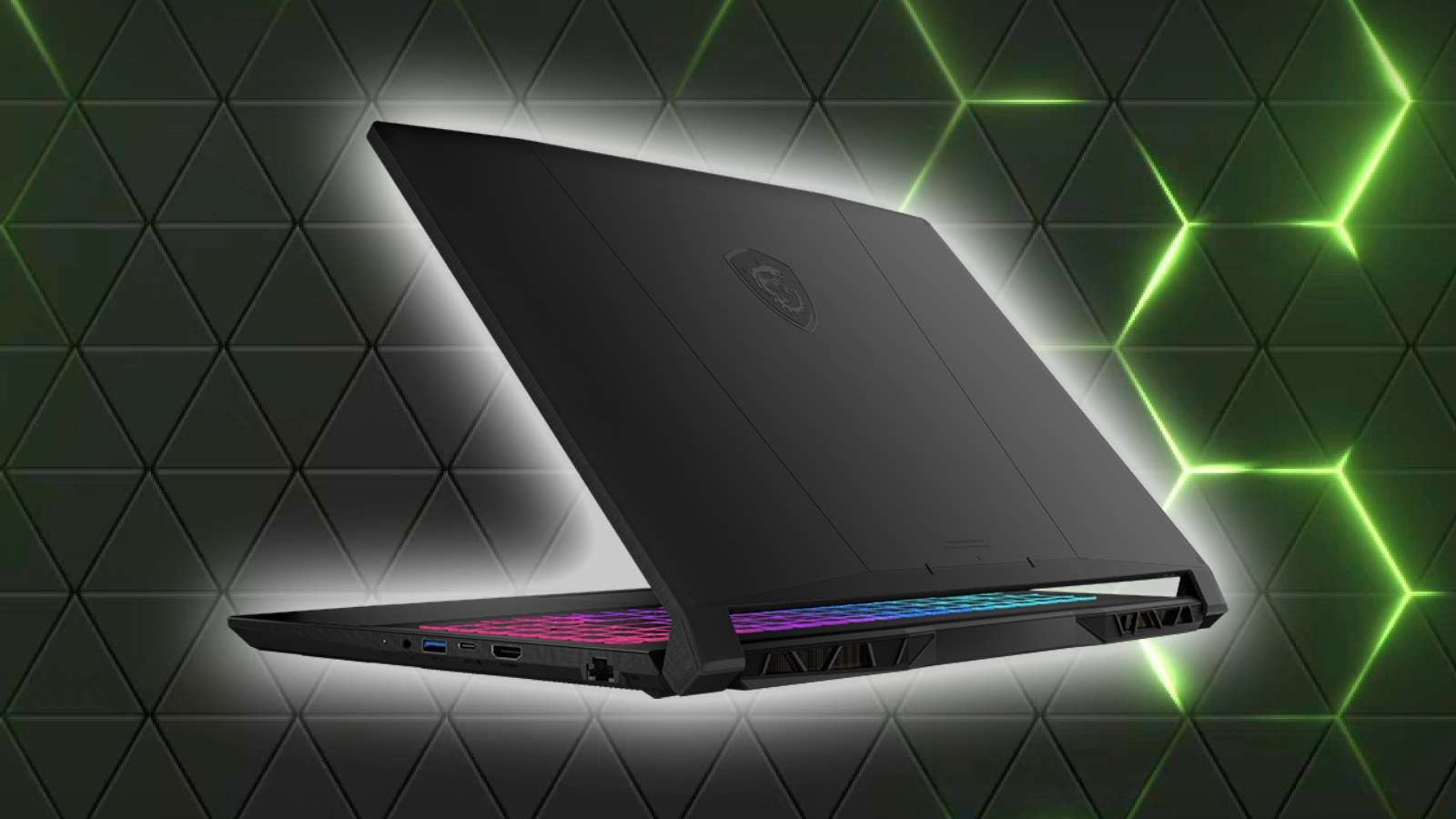Why Nvidia’s DLSS is a game changer for gaming laptops
 MSI / Nvidia
MSI / NvidiaIf you’re looking to play the latest and greatest games on the go, you might want to pick up a gaming laptop. But, if you’re worried about performance, DLSS could be the answer.
Getting a gaming laptop is a real hassle: There are so many things to consider when buying one, from screen size, to form factor and GPU. But, one piece of tech stands out above all others, which should play a part in what kind of gaming laptop you pick up this year.
Nvidia, AMD, and Intel all have various types of AI upscaling tech, whether that’s DLSS 2, FSR 2, or XeSS. These upscalers all work well, but with the new generation of graphics cards, Nvidia debuted DLSS 3 frame generation, which can massively boost your performance.

While DLSS 3 can be used for Cyberpunk 2077’s impressive overdrive mode on a beastly gaming PC, there are gains to be had in other areas too. Most notably, gaming laptops are known for being not quite as powerful as their desktop counterparts, with performance lagging behind to match.
But, thanks to frame generation, even modest gaming laptops with entry-level specs can see a huge boost in performance in the latest titles. I’ve tested two laptops in Horizon: Forbidden West and Cyberpunk 2077 to put these theories to the test.
DLSS performance tested
I’ve lined up two gaming laptops for testing, an entry-level HP Victus 15, featuring an Intel Core i5-12500H alongside an RTX 4050 mobile GPU, and a higher-end MSI Katana 15, featuring an Intel Core 19-13900H and RTX 4070 mobile chip respectively.
The HP Victus 15 can currently be had for under $1000, while the MSI Katana 15 retails for around $1500. But, what does your money get you when playing a modern title? I put it to the test in two games.
Horizon: Forbidden West benchmarks
In Horizon: Forbidden West, I tested both systems in the game’s opening areas at 1080p, and high settings. This will give you console-level fidelity, at a resolution supported by the gaming laptop. Thanks to the fast refresh rates shipping with most gaming laptops these days, you’re also going to get to enjoy variable refresh rates.
 Sony
SonySo, even if your framerate is underneath its maximum refresh rate, it’ll still look buttery smooth. But, how did both systems fare in Sony’s latest AAA to make it to PC?
| Benchmark | HP Victus 15 (i5-12500H / RTX 4050) | MSI Katana 15 (i9-13900H / RTX 4070) |
| Horizon: Forbidden West (High, 1080p, DLSS off) | 45 FPS | 62 FPS |
| Horizon: Forbidden West (High, 1080p, DLSS 2 Quality) | 61 FPS | 74 FPS |
| Horizon: Forbidden West (High, 1080p, FSR 2 Quality) | 58 FPS | 72 FPS |
| Horizon: Forbidden West (High, 1080p, XeSS Quality) | 62 FPS | 118 FPS |
| Horizon: Forbidden West (High, 1080p, DLSS 2&3 on) | 91 FPS | 109 FPS |
Kicking off with the HP Victus 15, without any upscalers involved, you’ll still be able to get a playable 45 FPS from Horizon Forbidden West, but, that’s ignoring all of the upscaling dark magic that’s been finely honed over the past five years.
Using AMD’s FSR 2 and Intel’s XeSS upscaling, the rival upscalers can go toe-to-toe with Nvidia’s DLSS Super Resolution in terms of performance. But, when inspecting captured video in an image analysis tool, both rival upscalers have more ghosting and artefacting than Nvidia’s option.
Cyberpunk 2077 benchmarks
In Cyberpunk 2077’s benchmark, I tested both systems at 1080p, using the Ultra settings preset, for better-than-console image quality. Ray tracing is also set to Ultra in these benchmarks, which offers a super high quality of fidelity, while also pushing Nvidia’s silicon to its limits.
| Benchmark | HP Victus 15 (i5-12500H / RTX 4050) | MSI Katana 15 (i9-13900H / RTX 4070) |
| Cyberpunk 2077 (Ultra, 1080p, RT Ultra, DLSS off) | 21 FPS | 32 FPS |
| Cyberpunk 2077 (Ultra, 1080p, RT Ultra, DLSS 2 Quality) | 35 FPS | 52 FPS |
| Cyberpunk 2077 (Ultra, 1080p, RT Ultra, FSR 2 Quality) | 36 FPS | 51 FPS |
| Cyberpunk 2077 (Ultra, 1080p, RT Ultra, XeSS Quality) | 33 FPS | 50 FPS |
| Cyberpunk 2077 (Ultra, 1080p, RT Ultra, DLSS 2 / 3/ 3.5 on) | 59 FPS | 83 FPS |
In Cyberpunk 2077, the HP Victus 15 with its humble RTX 4050 begin to struggle natively. But, turn an upscaler on, and you soon see increased performance to playable levels. The usual caveats for XeSS and FSR 2 apply: They are just categorically not as good as DLSS Super Resolution, and it’s clear when you see both running side by side or if you stop to analyze captured video.
 CD Projekt Red
CD Projekt RedFlicking DLSS 3 on is an absolute godsend here, bringing the title up to around 60 FPS consistently, with an occasional dip into the high 50s that you’ll barely notice.
The MSI Katana 15 tells us a similar story, once again pushing way past the “acceptable” 60 FPS territory and beyond, once again making use of a display with a fast refresh rate.
DLSS is a dealbreaker
Another thing to note is that DLSS is exclusive to Nvidia GPUs only. While you can use XeSS and FSR 2 on any GPU out there, DLSS is locked down. Of course, it’d be more consumer-friendly to open these protocols up as Intel and AMD have done. But, for now, you’re just going to have to go with Nvidia if you want to make use of the tech.
DLSS 3 frame generation also continues to be supported in the latest titles around launch, with over 70 titles currently supported, while AMD’s FSR 3 can take a while to land officially in games. Horizon: Forbidden West is just one example of a game that ships with DLSS 3 natively, but requires a mod for FSR 3 integration at the time of writing.
Regardless of support, DLSS 3 brings things to another level for gaming laptops. For entry-level GPUs like the RTX 4050, you can even take on Cyberpunk at ultra settings with heaps of bells and whistles turned on, and also get a console-beating framerate. Meanwhile, the more premium RTX 4070 mobile GPU screams past this and reaches for triple digits in the most demanding titles at 1080p. Without the various DLSS technologies applied here, the reality is quite different indeed.
If I were to go out and get a laptop specifically made for gaming, DLSS is just too good to ignore, no matter your budget.